Cuzco Pleases in This Year’s Mistura

Lima’s Campo de Marte fills with energy, flavor, and sound these days as the great food festival Mistura is in course. Beginning last Friday it goes through this weekend with workshops, restaurants, carts, a market, and lots of music and dance. Though located in Lima, Cuzco has a strong representation in this thrill of life, culture, and food.
Chef Luis “Cucho” La Rosa, of the Comedor Los Condoritos de Yanama, in Quispicanchis, Cuzco, received the prestigious Golden Rocoto Award (Rocoto de Oro) in the presence of Peru’s Minister of Agriculture Milton Von Hesse and the Bernardo Roca Rey, the President of APEGA. This award recognizes people with an ongoing commitment to preserving biodiversity, quality of production and a dedication to service.
Cuzco’s Rosita de Espinar (Silvia Rosa Huamaní) also called the “Diva of América” wowed the crowd Sunday night with her huaynos, an old and always new song style that keeps finding audiences with its slightly uneven rhythm and bounce. Known for her use of traditional instruments, such as the bandurria, Rosita de Espinar celebrates in her songs the experience of hard working, modern women with dreams of success in the complexity of today’s Peru where people from the highlands face particular difficulties.
While much of Peruvian food might stem from its cities and towns where people from many regions come together and professional chefs develop, its roots continue in Peru’s myriad communities across its diverse and broken geography. APEGA spent months searching throughout the country for representatives of the traditions of rural Peruvian cooking and invited these honored cooks to come to Lima and participate in Mistura’s presentation of Traditional Cooking. Of the women honored, three are from Cuzco: Isidora Palomino Jarac, from Pisac; Gumersinda Sota y Marcelina Quispe, del Sanctuary of the Parque de la Papa (the Potato Park); Rufina Cruz Jara, from Cuzco.

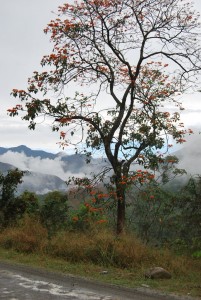
Cuzco is not just highlands. It also is rugged valleys with jungle and tropical lowlands. In the colonization zones and indigenous areas of Cuzco’s La Convención Province, where Machu Picchu lies, a unique variety of cacao grows, the fruit from which chocolate comes. Called chuncho it celebrates the lowland Indians who in Quechua are called chuncho and represented frequently in dances in Cuzco’s capital city. Indeed the area where it grows is the land of the Machiguenga people who may well have domesticated this variety of cacao. It is considered the finest cacao in Peru, with its mildness (low level of acidity) and its high level of fats, making it one of the richest and most aromatic of cacao’s. It is celebrated in Mistura’s Choclolate Corner, the Rincón del Chocolate.
However, if there is something that most strongly represents Cuzco in this year’s Mistura, it is something that in Cuzco humbly occupies a corner on the edge of the Plaza de Armas, under the Portal Belen, Tamales Josefina. In Cuzco, there is no big sign announcing their sale, nor a gleaming restaurant front with shiny tables where you can sit and eat, but Cuzqueños line up daily to buy and eat while standing these amazing tamales whose white corn is soft like a pillow and yet substantial. In Mistura Tamales Josefina has the joy of operating one of the competitive food carts and sharing both sweet and salty tamales, Cuzco’s essence, with the crowds of Lima.
Below we reprint the article we originally published more than a year ago on these bundles of hidden joy. (We are delighted to notice that our photograph of two tamales from that article was chosen to represent Tamales Josefina for the Mistura Webpage, though we wish they had asked permission and provided recognition. Nonetheless we join in celebrating Tamales Josefina and feel honored to have become part of the festival).
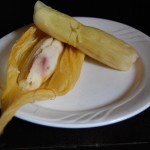
Tamales on the Plaza, A Cuzco Tradition
By Hebert Edgardo Huamani Jara
Translated by David Knowlton
Not only the millennial cradle of the Inca Empire and the imposing Machu Picchu, Cuzco also gave birth to the delicious tamales of Doña Josefina Ramírez Olivares.
Sold for decades under the Portal de Belen, on the Plaza de Armas, the tamales of Doña Josefina and her descendants have fed millions and have become a recognized and award winning Cuzco institution, even though the stand is so humble most tourists would never know.
But they should not pass up the amazing tamales. They are worth a stop.
The Ramirez family began the tradition of making and selling tamales in about 1924. That year, Doña Josefina started to sell her tamales on the Plaza de Armas, the main square, under the Portal de Belén, along with lechón, roast pork. And, in those days–as one might expect– well dressed people of culture and class would come by and have some tamales and lechón. Eating these tamales quickly became part of the Cuzco routine.
This was before the days of mechanized mills to grind the corn. As a result, Doña Josefina would first take the pointed end off of every grain of corn, peel them, then grind the corn by hand on a batán, or grinding stone. And, that may have been part of why her tamales came to be known as delicious.
While keeping the quality of her tamales, Doña Josefina sought to use new technologies as they became available. She began to take the corn grains separated from their points to the new mechanized mills once they opened. The Coronado family began one in Nueva Alta. She also took her corn to the new mill in Arcopunco. These were the first and only mechanized mills in Cuzco for a while. But once the Silva family opened a mill in San Blas, near where Doña Josefina prepared her tamales on Carmen Alta, she began taking her corn there.
Unfortunately Doña Josefina has passed on but her daughter, Doña Julia Huayllani de Caparo, carries on the tradition. Doña Julia relates that she began working with her mother as a young woman, but becuse it was hard work she stopped to study. However, when as a married woman her family suffered a crisis and for a year Julia could not find a job, she returned to work with her mother. It has now been some 40 years that she makes tamales.
Julia narrates that when she first began working they would have to mix the dough for the tamales by hand with large paddles. It was a demanding and tiring process, as the dough was quite stiff. As a result, Doña Julia was excited when they could get a mechanized mixer to do the work for them.
Although Doña Julia has sought to modernize production and make it more efficient, she has worked to maintain the same quality of product as always. Her tamales are justifiably famous.
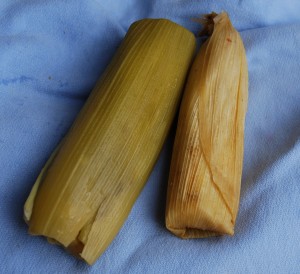
In 2010 she was invited to participate in the gastronomic festival “Mucho Gusto Peru” organized by PROMPERU and held in Cuzco. While there she received good write ups in the national press; in addition she came to the attention of prominent Peruvians, such as President Alan Garcia.
It was quite an honor for her tamales to be included in this event that also included some of the finest restaurants in Cuzco, such as Piskuo, Chicha, and Inka Grill, as well as some of the finest chefs from Lima, the national capital. Twelve thousand people consumed some 38,000 portions of food in the event, and Doña Julia sold some 700 portions of tamales.
Doña Julia says that being included in the Mucho Gusto Peru event was an enormous joy for her and her mother. She holds it was a reward for the hard work and sacrifice of maintaining the tradition of her family’s tamales.
Unless you are from Cuzco, you probably would not know that the lady who sits to one side of the Portal de Belen, in front of Gato’s Market, with bundles of tamales covered with a blue cloth, sells a product that has obtained such fame. But it has.
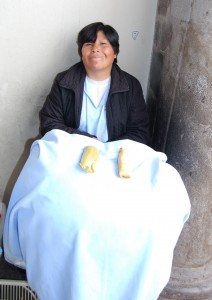
Doña Julia, at the present time, oversees the preparation of the tamales at her kitchen on Carmen Alta in San Blas. From 9 am to 2 pm Ms. Vicente sells the tamales with a shy smile, while in the afternoons Ms. yaneth Gomez replaces her until 8 pm when they pack up to prepare for another day.
Tamales are a Cuzco tradition, particularly those made from the giant white corn of the nearby Sacred Valley of the Incas. While they are traditionally consumed on November first for the feast of All Souls, they can be enjoyed year round. People constantly come up to Portal Belen to ask for tamales, all day long every day.
There are two kinds, sweet and salty, the latter with spicy meat. Doña Julia says that they are much the same as when her mother made them. Today, they must use smaller raisins and they no longer put slices of hard boiled egg or small, toasted yellow hot peppers in them. But they are still exquisite.
If you wish to experience one of the delicacies of Cuzco and join a tradition that is justifiably Doña Josefina’s but which also has roots in pre-Columbian times, visit the Portal Belen for a snack and try both a salty and a sweet tamale. Not only are they nutritious, they are delicious and will make you happy you tried them. You will return.
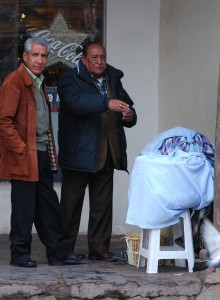
Although not Doña Josefina’s, here is a recipe for Cusco style tamales of white corn, for those who read Spanish.




